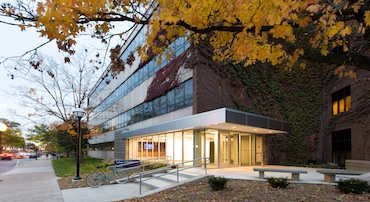
George Garcia, PhD
College of Pharmacy
428 Church St
Ann Arbor, MI 48109-1065
Summary
The Garcia lab research started in 1990 by exploring the post-transcriptional modifcation of RNA. Around 2010, we shifted our focus to a collaborative effort on antibiotic discovery for "neglected" diseases. Tuberculosis is a global human health problem of staggering proportions, causing 1.8 million deaths in 2016. Current TB drugs require up to nine months of treatment and poor compliance promotes the emergence of drug-resistant strains. Using both structure-based and high-throughput screening approaches, our collaborative team (the VMCC here at U-M, the Franzblau lab at UIC and the Murakami lab at Penn State) has discovered improved RNA polymerase inhibitors that circumvent some of the limitations of the current approved rifamycins. Shigella flexneri is a human enteropathogen that infects ca. 165 million people and claims more than 1 million lives per year worldwide. Targeting Shigella virulence pathways is attractive because such drugs would be expected to exhibit less emergence of drug resistance and have no effect on normal colonic microbiota. On our own and in collaboration withthe GSK and the Tres Cantos Open Lab Foundation, we have conducted very high-throughput screening (1.7M compounds) to find molecules that block Shigella virulence without bacteriacidal activity. Our most recent effort involves another collaboration (with the Clasby and Wobus labs at UM, the Artsimovitch Lab at Ohio State, the Murakami lab at Penn State and the Aldrich lab at U. Minnesota) to explore the potential of developing the rifamycin scaffold to inhibit the SARS-CoV2 RNA-dependent RNA polymerase.
After 35 years here at Michigan, including 11 years as department chair, Prof. Garcia will be retiring in April of 2025.
Research Interests
Developing novel antibiotics targeting eubacterial and mycobacterial (for tuberculosis) RNA polymerase
Virulence-targeted drug discovery against Shigella, one of the causative agents of acute diarrheal disease
Biosynthesis and physiological roles of the modified base queuine
Selected Publications
Miljković, M., Lozano*, S.A., Castellote, M.I., de-Cózar, C.D., Villegas, A.I., Gamallo, P., Jimenez-Alfaro-Martinez, D., Fernández-Alvaro, E.A., Ballell, Lluis, and Garcia, G.A., “Novel inhibitors that target bacterial virulence identified via HTS against intra-macrophage survival of Shigella flexneri”, mSphere (2023), https://doi.org/10.1128/msphere.00154-23.
Dow, G.T., Young, A.M., and Garcia, G.A., “Elucidation of the DNA-binding activity of VirF from Shigella flexneri for the icsA and rnaG promoters and characterization of the N-terminal domain to identify residues crucial for dimerization”, Journal of Bacteriology (2023), 205 (4), https://doi.org/10.1128/jb.00015-23. PMCID: PMC10127635.
Ragazzone, N.J., Dow, G.T., and Garcia, G.A., “Elucidating key interactions between VirF and the virB promoter in Shigella flexneri using E. coli MarA and GadX-based homology models and in vitro analysis of the DNA-binding domains of VirF and MarA”, Journal of Bacteriology (2022), 204 (9), https://doi.org/10.1128/jb.00143-22. PMCID: PMC9487632.
Ashkar, S.R., Rajeswaran, W., Lee, P.H., Thrasher, C.M., Franzblau, S.G., Murakami, K., Showalter, H.D.H., and Garcia, G.A., “Optimization of Benzoxazinorifamycins to Minimize hPXR Activation for Treatment of Tuberculosis and HIV Coinfection”, ACS Infectious Diseases (2022), https://doi.org/10.1021/acsinfecdis.1c00635, PMID:35772743.
Rajeswaran, W., Ashkar, S., Lee, P.H., Shin, Y., Franzblau, S.G., Murakami, K., Showalter, H.D.H., and Garcia, G.A., “Optimization of Benzoxazinorifamycins to Improve M. tuberculosis RNA Polymerase Inhibition and Treatment of Tuberculosis”, ACS Infectious Diseases, (2022), https://doi.org/10.1021/acsinfecdis.1c00636, PMID: 35772744.
Stefan, M.A., Velazquez, G.M., and Garcia, G.A., “High-throughput Screening to Discover Inhibitors of the CarD•RNA Polymerase Protein-Protein Interaction in Mycobacterium tuberculosis”, Nature Scientific Reports (2020), DOI: 10.1038/s41598-020-78269-3. https://www.nature.com/articles/s41598-020-78269-3.epdf.
Stefan, M.A., Ugur, F.S., and Garcia, G.A., "Source of the Fitness Defect in Rifamycin-Resistant M. Tuberculosis RNA Polymerase and the Mechanism of Compensation by Secondary Mutations”, Antimicrobial Agents and Chemotherapy (2018),62 (6), e00164-18, 1-13.




